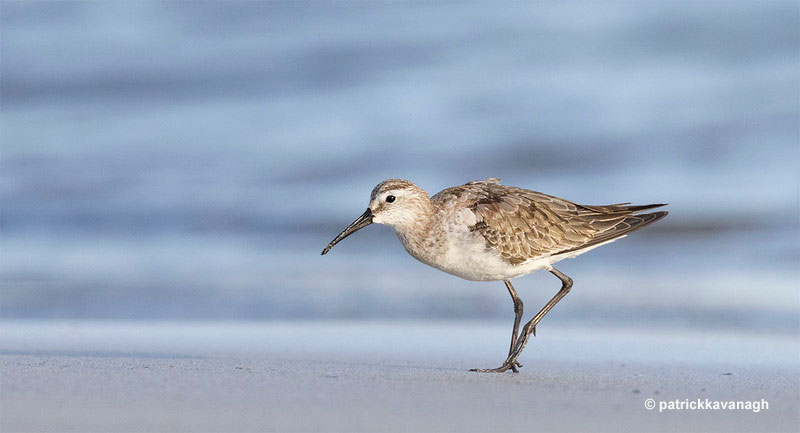Dunlin (Calidris alpina) is a small, chunky sandpiper with a longish, slightly downcurved beak. In winter, they are pale gray and above and on their chest, and have a white belly. In summer, Dunlins have orange on their upperparts and a black belly.
Big flocks of dull pale gray and brownish sandpipers on mud flats could be this species. They look like some other small sandpipers, but if you see a group of shorebirds that look a little bit larger and have longer beaks, you may have found a group of Dunlins!
Have you ever wondered why these birds are called Dunlins? Learn all about this impressive little shorebird in this article!
On this page
Identification
Dunlin are small sandpipers around 8.5 inches long, have a 17 inch wingspan, and weigh 2.1 ounces. They have a longish, slightly downcurved black beak, an indistinct pale eyebrow, and medium-length black legs.
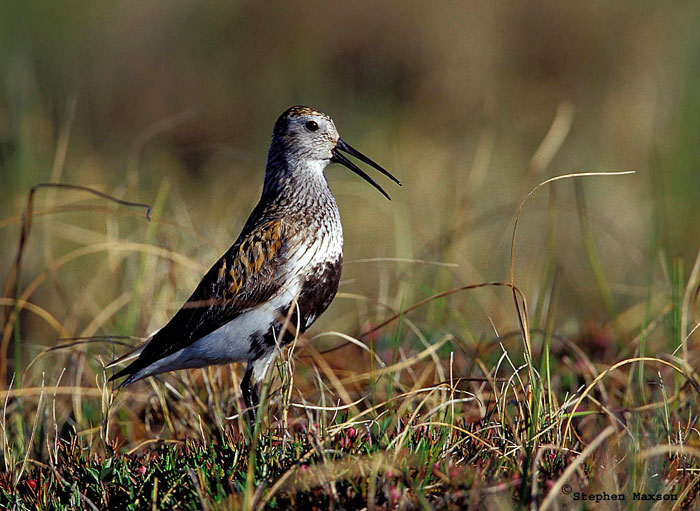
In breeding plumage, male Dunlins are pretty birds with orange and black on their back and upper wings. They also have a large black patch on their white belly, some orange on their crown, and fine dark markings on their face, neck, and breast.
Females look like males but are not as brightly colored. They also have darker marks on their face, neck, and underparts, and some pale brown on their face and neck. Young birds look like females but don’t have any bright orange in their plumage.
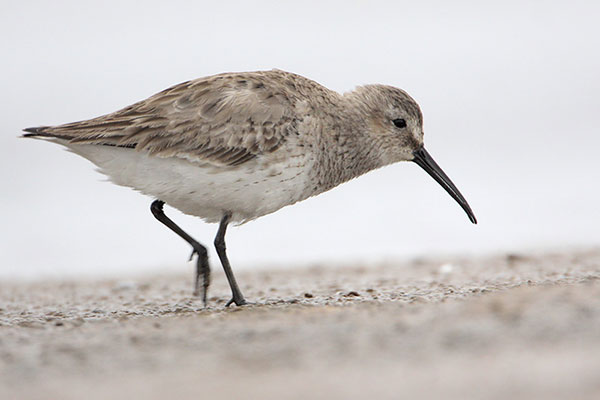
In winter, these dumpy little shorebirds are pale gray with pale brown highlights above, on their head, and on their chest. They also have white bellies with some small dark marks on their chest.
During very fast flight, Dunlins show a narrow white stripe on each of their long, pointed wings. We can also see a white patch on each side of their rump.
Vocalizations
Dunlins usually make short peert calls but males also sing a longer, trilled song on their breeding grounds. It sounds like, chert chert chert treeeeeeeeeeeeeeeee.
Food
Dunlins feed on a variety of insects, small mollusks, marine worms, and other small aquatic creatures. Once in a while, they also eat some plant matter but those small animals make up the majority of their diet.
On their breeding grounds, these small sandpipers mostly eat sawflies, caddisflies, beetles, mites, wasps, snails, and slugs. They catch these food items by using their beak to pick them from the edges of lakes, ponds, and other wetlands in the tundra. At this time of year, they also forage on their own or in pairs.
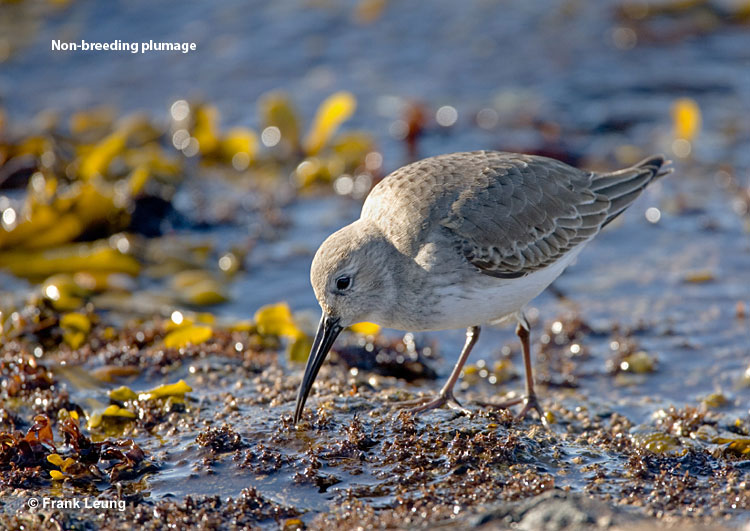
During migration and winter, Dunlins still eat insects, but most of their diet consists of marine worms, small clams, and other little mollusks. They forage for these small animals by walking on mud flats and using their beaks to probe into soft mud.
They often hold their beak open as they stick it into the mud, possibly so they can use their taste buds to find the best prey. When they detect a worm or clam, Dunlins pull it out of the mud and wash their food before they eat it.
These sandpipers can occasionally show up at sewage ponds and other wetlands but they much prefer foraging in flocks on big coastal mud flats.
Nesting and Eggs
Dunlin form pairs in late May or June, not long after they arrive on their breeding grounds. The male bird uses its feet and chest to scrape out several shallow depressions in tundra vegetation. They make them in and near tussocks of grass and line them with bits of sedges, grass, and willow leaves.
After they make several nests, male Dunlin shows them to their mate. She chooses one and lays three to four brown, olive-buff, or blue-green eggs covered in orange-brown markings.
The eggs are 1.4 inches long, weigh 0.39 ounces each, and are incubated by both parents for 22 to 24 days. In general, the mother Dunlin does more of the incubation duties, especially at night.
Nestling Dunlins leave their nest just a few hours after hatching and feed on their own. However, both parents lead them to sites with abundant insects they can easily catch and eat.
After six days, their mother leaves her young, but their father stays with them for 19 or so days. At that time, the baby Dunlins are just starting to learn to fly.
As soon as they can take flight, they flock with other juvenile Dunlins at inland wetlands. By August, they fly to coastal habitats to flock with adult birds.
Current Situation
The Dunlin is a common shorebird that breeds in tundra habitats in Alaska, Canada, and northern Eurasia. It migrates through many areas but mostly along coastlines. This species also winters in coastal habitats, especially in estuaries and large mud flats. They winter from Canada to Mexico, and in Europe, Africa, and Asia.
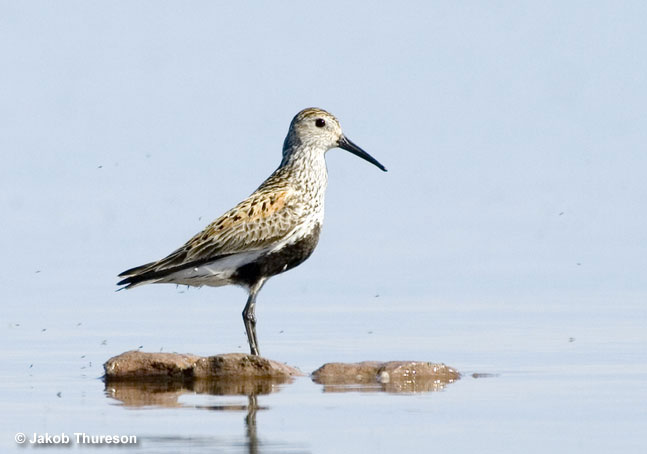
This species is listed as Least Concern in the IUCN Red List and is a common bird in most of its range.
Dunlin have a large and stable population estimated at 1.4 to 1.6 million individuals. They are not considered threatened but there is some concern that populations are decreasing in some areas. Such decreases could happen if the mud flats they require are degraded or eliminated.
Fortunately, in North America, this species is protected and winters in several coastal reserves. However, birds that winter in eastern Asia and some other places could become threatened by coastal developments.
Facts
- Shorebirds rarely hybridize with each other. However, hybrids between the Dunlin and two other species that also nest in the high Arctic have occurred. On very rare occasion, Dunlins have bred with Purple Sandpiper and the White-rumped Sandpiper. Their offspring look like a blend of each parent species.
- The name of this species comes from the old English word, “dunling”. This word means “little brown thing”, a term that accurately describes this plain little shorebird.
- To escape falcons, Dunlins fly as fast as 50 miles per hour. When they detect a predator, like other shorebirds, they quickly take to the air in tight, synchronized flocks.
- The Dunlins that breed north of the Seward Peninsula in Alaska don’t migrate to California or other sites in North America. Instead, these birds spend the winter in Japan, Korea, and other sites in eastern Asia.
- During hailstorms, Dunlins stand up and point their beaks to the sky. This posture may protect its beak from being damaged.
Similar Species
The Dunlin is easily recognized in summer, but most birders don’t see them in their breeding plumage. Instead, they see them in their much more challenging and plain winter plumage.
Western Sandpiper
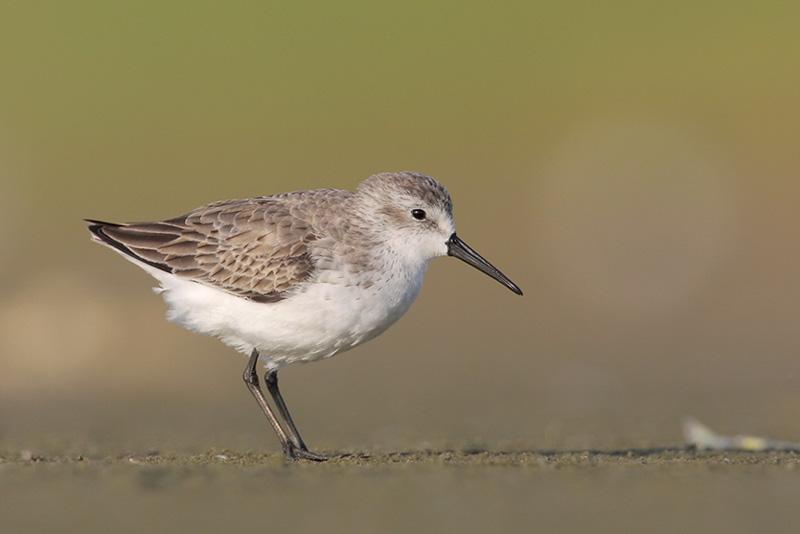
The Western Sandpiper has a similar shape and can look a lot like the Dunlin during the summer.
However, it never has a black belly, is smaller, and has a smaller beak. It is also paler gray and white, while Dunlins have pale brown on their face and chest.
Semipalmated Sandpiper
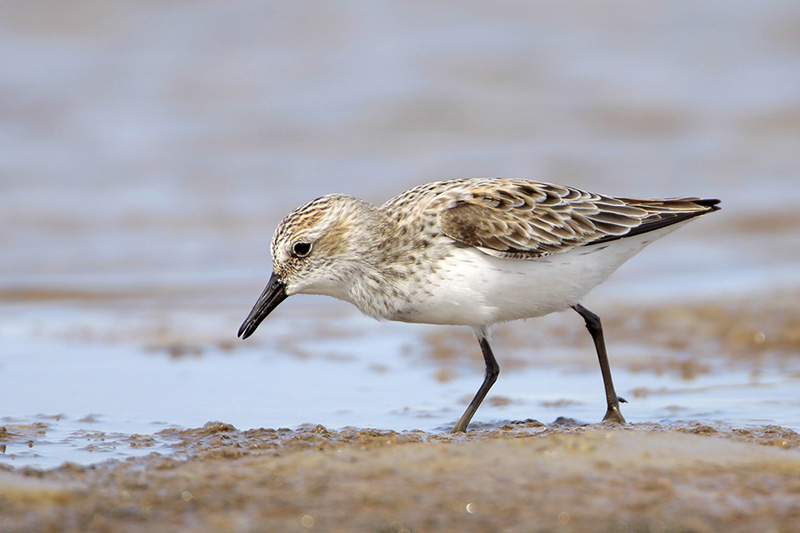
Photograph © Greg Lavaty.
In winter, Dunlins also look a lot like Semipalmated Sandpipers. However, Semipalmated Sandpipers are smaller and always have a much smaller, straighter beak than the Dunlin’s long bill.
Curlew Sandpiper
The Curlew Sandpiper is a rare visitor to North America but, in winter, can look a lot like a Dunlin. In summer, its red-brown plumage makes the Curlew Sandpiper an easy bird to identify.
However, in winter plumage, Curlew Sandpipers are best separated from Dunlins by their longer beak, paler gray coloration, and wings that extend beyond their tail.
Frequently Asked Questions
What kind of bird is a Dunlin?
A Dunlin is a type of sandpiper.
How do you identify a Dunlin?
You identify a Dunlin by the black patch on its belly, or the long, slightly decurved beak and pale brown color on its face and chest.
Where are Dunlins found?
Dunlins are found in the tundra and on coastal mud flats.
Is a Dunlin a sandpiper?
Yes, a Dunlin is a sandpiper.


